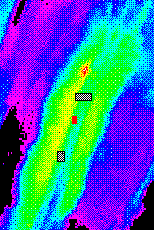
![[Map of Dive Track]](track_3003.gif)
Port Observer: Lilley
Starboard Observer: Kelley
Pilot: Hickey
Date: 9/23/95
Summary
Dive Goals: The goals of this dive involved completing a detailed Mesotech survey to delineate the southern tip of the horst on which the High Rise Field lies and to complete transect sampling of Godzilla.
Dive Summary: We landed just northeastward of Fairy Castle near the western median valley wall. A Mesotech survey was initiated at 09:32 at X=5900, Y=8100 and consisted of 7 E-W running Mesotech lines spaced 40 m apart with a 60° swath width and an average length of 300-400 m. The lines were successful in bounding the eastern and western walls of the horst and delineating new sulfide deposits. We were unsuccessful, however, in imaging the southern tip as it most likely lies ~100 m south of were the Mesotech survey was terminated. During the survey we crossed sulfide structures that were aligned subparalled with the eastern wall of the bounding scarp and which were fairly common along the scarp. At least 3 new sulfide structures south of Godzilla at 5743, 8022, 5652,7915, and 5678, 7980 were observed. We dove on the first and second of these sites, the first of which was marked by an old polypropylene line that was entangled around the sulfide structures. This site is extensive and contains isolated fields of concentrated tub worms and bacterial mats, as well as abundant small sulfide spires. These structures are concentrated along the base and up the wall of the eastern edge of the horst along a large talus scarp, consistent with this structure channeling fluid flow in this area. This site was not intensely explored due to fear of becoming entangled in the line, but it appears to be quite extensive. Subsequent to completion of the Mesotech survey we traversed north to Bambi and Godzilla. The base of Bambi is characterized by localized zones of bacterial mats along fractures in basalt and progressively abundant bulbous flanges that are pervasively encrusted with tube worms and bacterial mat. These highly colonized zones are interspersed with non colonized flanges. Water samples were taken from a semi-robust smoker hosted on top of a worm infested flange that looked moss covered and lacked a chimney structure. Prior to sampling a hole was dug through the worms to obtain direct access to the fluids where port gas tight and port major bottles were fired in the vent orifice and a temperature of 335.7°C was measured. The new sonar system was tested at both the plumes at Bambi and Godzilla, but was most successful at imaging Bambi where the plume was more concentrated. We then went to Godzilla to a heavily colonized flange with a well developed reflecting pool where a temperature of 318°C was measured and starboard gas tight and port inner major manifold samples were taken. We moved to a new flange with abundant diffuse flow and another well developed reflecting pool, ~ 4 m upslope where a temperature was measured of 333.6°C and major #4 and gas tight #7 were sampled. At marker AJ a temperature of 335.6 was measured from a flange and majors #6 and 10 were fired, as well as gas tights # 2 and #5, with a temperature of 333°C. Major #5 was then sampled, gas tight #6 were sampled from underneath a flange with a temperature of 333-334°C and a bio sample was taken from the edge of the flange structure. Power was running out so Niskin samples were taken at the edge of the flange at blue=2115 m, yellow = 2116 m, and red = 2118 m.